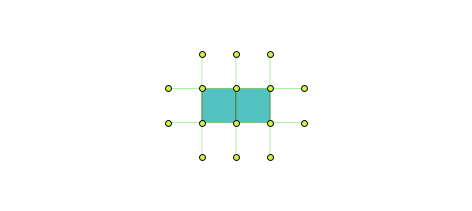This is a shell script showing how Postgis topologies can be used to convert linestring geometries into topologically valid polygons.
It uses geometry points within polygons to associate the created polygons with attribute data, and checks that all points have a matching polygon and the no points share a polygon. It was a useful learning exercise for me to work with topologies & will hopefully help others as well.
#! /bin/bash
# Working example of Postgis topology use
#
# Brent Wood 9 April 2012
# email: pcreso(at)pcreso.com
# With thanks to strk!!
# Creates clean database & tests basic topology construction
#
# SUMMARY:
# Uses geometry linestrings
# Adds these to topology to create nodes/polygons
# Uses table of geometry points & attributes
# Extracts topo polygons to match points & attributes
# Checks for points with no polygons & for points sharing a polygon
# create new empty database
dropdb topo
createdb topo
# install full postgis with topology support
# modify paths as appropriate for other setups
psql -d topo -qf /usr/share/postgresql/contrib/postgis-2.0/postgis.sql
psql -d topo -qf /usr/share/postgresql/contrib/postgis-2.0/spatial_ref_sys.sql
psql -d topo -qf /usr/share/postgresql/contrib/postgis-2.0/legacy.sql
psql -d topo -qf /usr/share/postgresql/contrib/postgis-2.0/topology.sql
psql -d topo -qf /home/baw/Downloads/postgis-2.0.0rc2/doc/postgis_comments.sql
# create table with overlapping linestring geometries
psql -d topo -qc "create table lines
( id serial primary key,
name varchar(6),
geom geometry(LINESTRING,4326));"
# add a set of linestrings to the table, like this
#
# | | |
# -------------------
# | | |
# -------------------
# | | |
psql -d topo -c "insert into lines values
(default,
'top',
ST_Setsrid(ST_Makeline(ST_Makepoint(175,-44),ST_Makepoint(179,-44)),4326)
);"
psql -d topo -c "insert into lines values
(default,
'bottom',
ST_Setsrid(ST_Makeline(ST_Makepoint(175,-45),ST_Makepoint(179,-45)),4326)
);"
psql -d topo -c "insert into lines values
(default,
'left',
ST_Setsrid(ST_Makeline(ST_Makepoint(176,-43),ST_Makepoint(176,-46)),4326)
);"
psql -d topo -c "insert into lines values
(default,
'middle',
ST_Setsrid(ST_Makeline(ST_Makepoint(177,-43),ST_Makepoint(177,-46)),4326)
);"
psql -d topo -c "insert into lines values
(default,
'right',
ST_Setsrid(ST_Makeline(ST_Makepoint(178,-43),ST_Makepoint(178,-46)),4326)
);"
# create new empty topology structure
psql -d topo -qc "select CreateTopology('topo1',4326,0);"
# add all linestrings to topology in one operation as a collection
psql -d topo -c "select ST_CreateTopoGeo('topo1',ST_Collect(geom))
from lines;"
# creates topology like this (X = polygons - faces, + = nodes)
# + + +
# | | |
# +-+---+---+--+
# | X | X |
# +-+---+---+--+
# | | |
# + + +
# validate topology - identify errors
psql -d topo -c "select * FROM ValidateTopology('topo1');"
# list topology contents
psql -d topo -c "select TopologySummary('topo1');"
# list polygons in ExtWKT format
psql -d topo -c "select ST_AsEWKT(ST_GetFaceGeometry('topo1', 1));"
psql -d topo -c "select ST_AsEWKT(ST_GetFaceGeometry('topo1', 2));"
# create stratum polygon table for geometries as polygons
psql -d topo -c "create table poly
( id serial primary key,
topo_id integer,
name varchar(10),
point geometry(point,4326),
geom geometry(polygon,4326));"
# populate polygon table with non-polygon data -
# use points to geolocate the created strata, & associate the faces as geometries
psql -d topo -c "insert into poly (id, name, point) values
(default,
'stra1',
ST_Setsrid(ST_Makepoint(176.5,-44.5),4326));"
psql -d topo -c "insert into poly (id, name, point) values
(default,
'stra2',
ST_Setsrid(ST_Makepoint(177.5,-44.5),4326));"
# insert a record with a point outside of any generated polygon to test error case
psql -d topo -c "insert into poly (id, name, point) values
(default,
'stra3',
ST_Setsrid(ST_Makepoint(177,-43.9),4326));"
# insert a record with a point inside the same stratum polygon to test error case
psql -d topo -c "insert into poly (id, name, point) values
(default,
'stra4',
ST_Setsrid(ST_Makepoint(177.5,-44.4),4326));"
# check for any points without generated polygons
psql -d topo -c "select 'ERROR: no enclosing polygon for point' as error,
name,
id,
ST_Astext(point) as point
from poly
where GetFaceByPoint('topo1',point,0) = 0;"
# add polygons from topology matching the points
psql -d topo -c "update poly
set
geom=topology.ST_GetFaceGeometry('topo1',GetFaceByPoint('topo1',point,0))
where GetFaceByPoint('topo1',point,0) != 0;"
# check for any points with the same polygon
psql -d topo -c "select 'ERROR: points in same polygon' as error,
name,
id,
ST_Astext(point) as point
from poly where geom in
( select geom from poly
group by geom
having count(geom) >1 );"
Last modified
13 years ago
Last modified on 04/08/12 17:10:07
Attachments (1)
- topo.png (2.0 KB ) - added by 13 years ago.
Download all attachments as: .zip
Note:
See TracWiki
for help on using the wiki.

